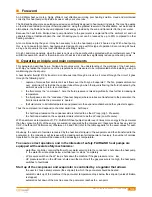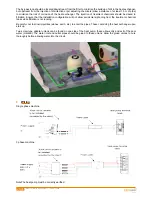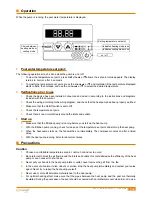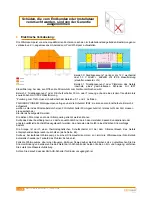
15/36
2015/12 - Indice de révision : F - Code : 33436
Foreword
An Air/Water heat pump is a highly efficient cost effective swimming pool heating solution. Used and maintained
correctly, this heat pump will provide its owner with years of service.
The Fairland heat pump is an autonomous device, specifically designed to heat swimming pools. The machine works
on the tried and tested principles of thermodynamics: using the greatest reservoir of heat available, our world and its
atmosphere, the Fairland heat pump captures heat energy provided by the sun and transmits it to the pool water.
Because the heat that a Fairland heat pump transfers to the pool water is captured from the ambient air, and not
generated like a traditional boiler, the cost of heating your pool can be reduced by up to 80% compared to other
heating solutions.
At some times during the year, it may be necessary to run the heat pump up to 24 hours a day. With a heat pump,
this is not a cause for concern, heat pumps are designed to cope with this type of operation. Even running 24 hours
a day, a heat pump is the most cost effective pool heating solution.
At night, and more generally, when the pool is not is use, the pool should be protected with an isothermal cover. This
will limit evaporation, which is the main source of heat loss, and will thus significantly reduce pool heating costs.
Operating principle and main components
This paragraph describes how a Fairland heat pumps work. An understanding of the workings of the heat pump
will help you realise the importance of the preparations and measures to be implemented before installing, using or
maintaining your heat pump.
A heat transfer fluid (R 410A) travels in a continuous loop through a circuit. As it moves through the circuit, it goes
through the following cycle:
1.
capture of calories from ambient air as it flows over the fin-type “evaporator”. The fan propels ambient air
over aluminium fins that line the copper tubes through which the liquid is flowing; the fluid is heated by the
ambient air which, in turn, is cooled down.
2.
the fluid enters the “compressor”, here the fluid pressure is raised significantly thus further increasing its
temperature.
3.
the fluid passes into the “condenser” (heat exchanger) where calories are transferred to the pool water, the
fluid is cooled while the pool water is heated.
4.
the fluid returns to its initial temperature and pressure in the expansion chamber and the cycle starts again…
Thus the compressor and expansion chamber delimit two half-loops:
•
the half-loop situated on the condenser side is referred to as the HP loop (High Pressure).
•
the half-loop situated on the evaporator side is referred to as the LP loop (Low Pressure).
With an ambient air temperature of 15°C, FAIRLAND heat pumps transfer over 4 times more energy to the pool water
than they consume (90% of the energy consumed is consumed by the compressor): these machines have a yield (or
COP - Coefficient of Performance) of between 4.5 and 7.80 (refer to the table opposite for the exact values for each
model).
Obviously, the number of calories recovered by the heat transfer liquid in the evaporator, and then transferred to the
pool water in the condenser, will increase with increasing ambient air temperature. Inversely, the number of calories
transferred to the pool water will decrease with decreasing air temperature.
To ensure correct operation, and in the interests of safety, FAIRLAND heat pumps are
equipped with several safety mechanisms :
•
water flow controller, controls the flow of pool water entering into the condenser: shuts down the heat pump
if the water flow rate drops below a certain level or stops completely
•
LP pressure switch on the LP loop: shuts down the machine if the gas pressure is too low
•
HP pressure switch on the HP loop: shuts down the machine if the gas pressure is too high, the heat pump
switches to fault mode
Start up of the compressor and evaporator is controlled by a regulator that allows:
•
the user to choose a temperature (the set-point) to which the pool water should be heated
•
automatic start up of the machine if the pool water temperature drops below the set-point (unless filtration
is stopped)
•
automatic shut down of the machine once the pool water reaches the set-point




































